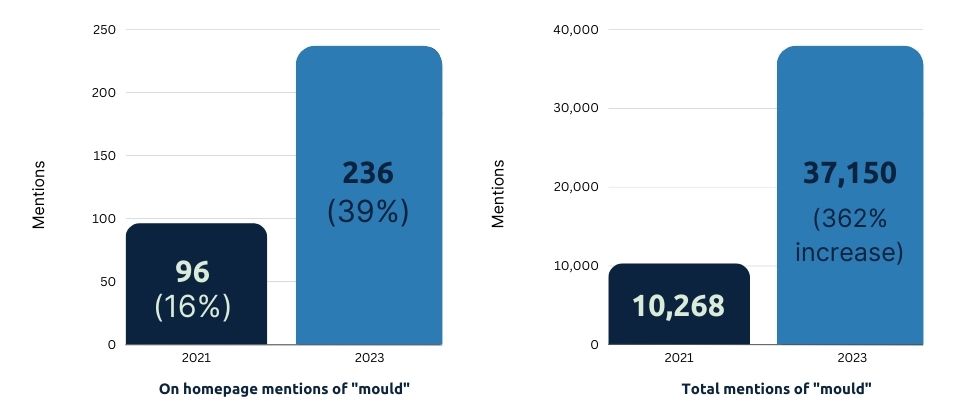Blog post - The impact of damp and mould on the social housing sector
Description
Damp and mould has had far-reaching impacts on the social housing sector and continues to cause harm for residents.
Published
22nd February 2023
Author
Simon Wilkes
Read time
4 minutes
The impact of damp and mould in the social housing sector can be far-reaching and has the potential to cause serious harm to residents, building structures, and the reputation of social landlords and housing associations.
A recent report has also shown that more than a fifth of homes in the UK suffer from damp, mould or condensation (Source: Cheshire Live), yet for many it feels like the seriousness of this issue isn’t being respected by those with authority.
Major health risks
One of the primary concerns associated with damp and mould in the social housing sector is the health risks they pose to residents. Exposure to damp and mould can lead to a range of respiratory problems, including asthma, allergies, and other respiratory illnesses. These health problems can have a significant impact on residents, particularly those who are vulnerable, such as children, the elderly, and people with pre-existing health conditions.
In addition, damp and mould can also cause skin and eye irritation, headaches, and other health problems, which can further impact residents’ quality of life. The longer the response time from social landlords, the more susceptible residents are to these listed issues, which is why it is incredibly important that repair diagnostics and appointment management tools such as Active Diagnostics are being used where possible by tenants and staff members.
An expensive oversight
Addressing damp and mould problems in social housing can be costly, both in terms of the cost of repairs and renovations, as well as the cost of temporary housing for residents while work is being carried out. Social housing providers may struggle to balance the need to maintain their properties with the financial constraints they face, which together affects the safety and habitability for residents.
In some cases, the cost of addressing damp and mould problems may be so significant that social housing providers are forced to choose between repairing the property or providing adequate support and services to residents. Which bids the question, is enough being done to support the affected residents living in the UK?
But where social housing providers may think fixing the damp and mould issues is too expensive, a report in 2021 showed that £87,553.97 in compensation was ordered across 177 cases (Source:Housing Ombudsman), with maladministration also accounting for 40% of those; once again indicating the importance of a reliable diagnostics and appointment management tool.
Prevention is key
Preventing damp and mould problems in the social housing sector is essential to protect the health of residents and the structural integrity of buildings.
In most cases this can be achieved by communicating with residents on how to correctly ventilate their property and make small lifestyle changes to prevent damp and mould. This could simply be in the form of more prominent information on a landlords website, however, we have seen a number of landlords step up their game with informative videos and leaflet postal campaigns.
Our research has shown that communication has significantly improved in recent months. In the last 2 years social landlords mentions of mould has almost quadrupled, with 39% of website mentioning mould within one click from the homepage (compared to 16% 2 years ago).
Out of 599 websites, how many mention mould within 1 click of the homepage?

Although just mentioning damp and mould isn't enough to resolve the issue at hand. Social housing providers should take a proactive approach to preventing damp and mould problems, including regular inspections and maintenance of properties, providing adequate ventilation and insulation, and addressing any leaks or other sources of moisture as quickly as possible.
Where damp and mould problems do occur, it is important that social housing providers take prompt and effective action to address them. This may include repairing leaks and other sources of moisture, installing ventilation systems, and carrying out renovations and repairs to correct any structural damage. In some cases, it may be necessary to relocate residents while work is being carried out to ensure their safety and well-being.
It's time to take a stand
Preventing damp and mould problems is essential, and where they do occur, prompt and effective action must be taken to address them. By taking a proactive approach to preventing damp and mould problems and addressing them promptly when they do occur, social housing providers can ensure that residents have safe, healthy, and habitable homes.
This isn’t one person’s problem i.e., the customer, the social housing provider, or members of staff. We are all members of one body in a way, and if we can work together to solve this big issue, fewer residents will be affected and the better we can protect the future of the infrastructures that home millions around the country.
Are you looking for a diagnostics solution that can help with damp and mould, or maybe better ways to communicate information with residents.With specially designed products & services to serve organisations in the housing sector, Active Housing has you covered. Find out more: /products-services

